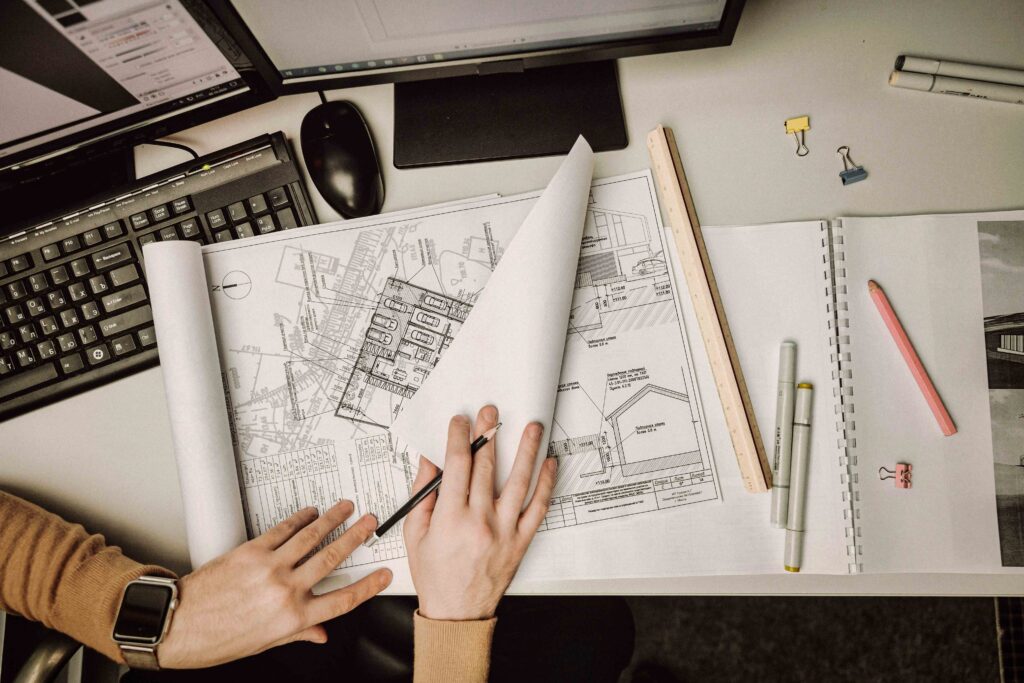
Embarking on an architectural journey requires a blend of foundational skills and advanced techniques. It’s all about developing a well-rounded skill set that turns creative ideas into impressive designs. It’s a journey that not only sharpens your technical abilities but also prepares you to present your vision with impact.
Sketch

Many believe that strong drawing skills are essential before starting architecture studies, but that’s a misconception. While having good sketching abilities can speed up your progress, it’s not a prerequisite. You’ll have ample opportunity to develop your drawing skills during the five-year architecture program.
Hand-drawing offers a unique experience that computer software cannot replicate. While software can produce precise lines based on your commands, it lacks the intuitive creativity that comes from drawing by hand. This natural fluidity helps transform imagination into vision.
In the early years of architecture school, you’ll focus on freehand drawing to develop your sense of scale and proportion, which are crucial for understanding the relationship between a building and its users. This skill will be essential throughout your architectural career.
Architectural Drawing
The next step after mastering freehand drawing is learning architectural drawing. This type of drawing introduces you to a universal language used by architects and engineers in building construction. Architectural drawings follow established conventions and standards that allow you to clearly and effectively communicate your design ideas.
In both academic and professional settings, these drawings play a crucial role in explaining and detailing a building design. They provide a standardized method for representing various aspects of a project, making it easier for others to understand your vision. Whether you’re working with construction laborers or professional designers, architectural drawings use a common “grammar” that facilitates clear communication and ensures that everyone involved can accurately interpret the design. This universal approach to drawing is essential for successful collaboration and project execution in the field of architecture.
3D Modeling

So far, we’ve discussed skills related to two-dimensional design. However, 2D drawings alone are often not sufficient for fully conveying a designer’s vision. This is where software proficiency, particularly in 3D modeling, becomes essential. 3D modeling allows designers to explore their ideas more deeply, as new insights and decisions often emerge when a 2D design is translated into three dimensions.
There are numerous software tools available for creating both 2D and 3D drawings. Skipping the sketching phase and jumping straight to computer work can lead to less satisfactory results, as the initial hand-drawn sketches are crucial for developing a solid design foundation.
Interestingly, the 3D modeling industry extends beyond architecture. It plays a significant role in fields like video games and animated movies. For instance, the iconic Hogwarts castle in the Harry Potter series was designed by actual architects. Similarly, the popular Assassin’s Creed video game series, developed by Ubisoft, employs architects to create historically accurate environments for its game maps. This is why these virtual worlds appear so realistic. Thus, a background in architecture can open doors to careers in game and computer graphics development, especially if you have a passion for 3D modeling.
Visualization
While 3D modeling can be enjoyable for developers, it becomes more accessible through rendering and visualization. Rendered images can be understood by people who may not have a background in architecture. There are many software options, both paid and free, available online that include rendering engines. Visualization is a significant industry, much like 3D modeling and rendering is essentially the next step after creating a 3D model.
Rendering involves converting a 3D model into a realistic image, which often requires powerful hardware due to its high computational demands. As a result, rendering is a resource-intensive process that consumes substantial amounts of power. There are numerous career opportunities in the field of 3D modeling and rendering beyond traditional architecture. These include :
- Video Game Design : Creating detailed and realistic 3D environments and characters for video games.
- Animation : Developing characters, scenes and effects for animated movies and TV shows.
- Virtual Reality (VR) and Augmented Reality (AR) : Designing immersive environments and interactive experiences for VR and AR applications.
- Film and Television : Producing visual effects (VFX) and CGI elements for movies and TV shows.
- Product Design : Visualizing and prototyping products in 3D before manufacturing.
Mastering Presentation
A great design can remain unnoticed if it is not presented effectively. A strong presentation can significantly enhance a project’s impact. Designers must be skilled in creating compelling presentation sketches, architectural drawings and 3D renderings. These elements must be professionally presented to clients. This is a very promising skill to become a graphic designer.
This is why architectural students are trained throughout their academic careers to present and defend their designs before a jury of studio teachers. This training is crucial because a successful architect is not just a talented designer but also a skilled communicator and salesperson. Mastering the art of presenting and selling designs is essential for thriving in the architectural profession.
In conclusion, architecture is a vast field with numerous opportunities to explore and specialize in areas that align with your passion. It offers many paths for choosing the career that best suits your interests.


